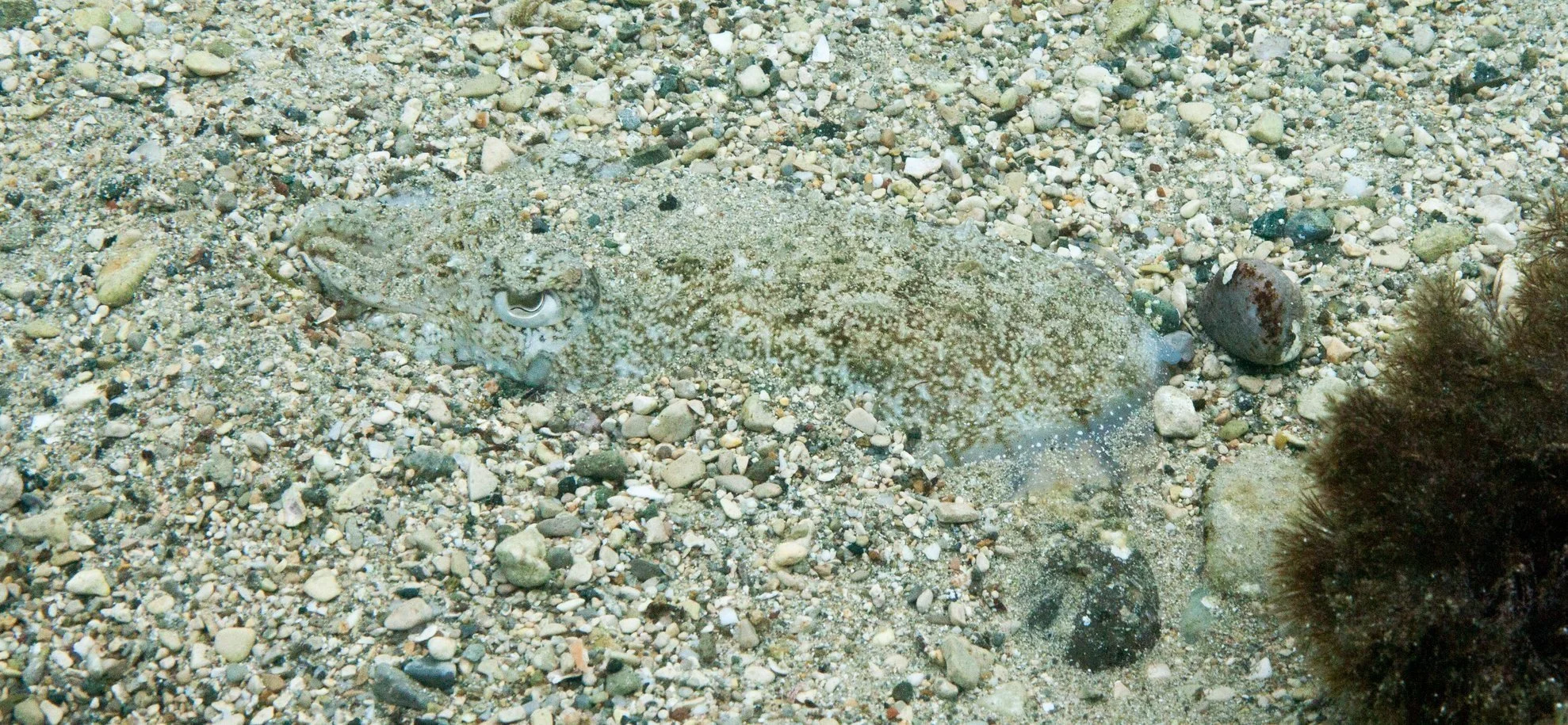BLOG BY ALEX
An Eye for Camouflage
Written by Alex K. Schnell
Can you spot the cuttlefish? Cuttlefish are masters of disguise. Perhaps the only giveaway in this image is the animal’s skirt-like-fin exposed at the base of the mantle or the black contracted pupil forming a unique W-shape.
Animals of all kinds exhibit weird and wonderful defence tactics to stay concealed from potential predators. Still, none are as impressive as the dynamic camouflage abilities of cuttlefish, octopus, and squid. These soft-bodied marine molluscs, known as cephalopods, can camouflage instantly through neural control of pigmented cells in their skin. These shape-shifters can melt into diverse marine backgrounds using a combination of pixelated colours, body contortions, and skin textures. The resulting camouflage patterns are simply captivating…if you can spot them!
So how do cuttlefish decide what camouflage they should ‘wear’ to blend in with a particular background? We know that camouflage behaviour is not a simple reflex, like how we get goosebumps when we’re cold. Rather dynamic camouflage relies on fast decision-making guided by processing visual information from the surrounding environment. Yet cuttlefish habitats rarely resemble a uniform canvas; instead, they must blend into mismatched backgrounds, including clumps of algae, rocky outcrops, and different coloured substrates. This no doubt requires a significant amount of brain processing.
To understand this process, we must first understand that the cuttlefish brain has drastically diverged from the vertebrate brain. For starters, the cuttlefish brain is shaped like a doughnut, comprised of approximately 30 lobes (most vertebrates have 4 lobes), and unlike vertebrates, cuttlefish do not have clear brain hemispheres. Despite not having a ‘divided’ brain, cuttlefish, like humans, appear to process visual information in different sides of the brain. This phenomenon, known as lateralization, has been observed in most animals including horses, chickens, toads, and even bees! But lateralization has never before been investigated in the context of camouflage.
We set out to investigate whether cuttlefish prioritize visual information in their right or left visual field during camouflage behaviour. To test this we presented cuttlefish with mixed substrates, that is, different types of visual information to the left and to the right of them. We found that cuttlefish have a right eye preference because they selectively used substrate brightness in their right visual field to adjust the overall brightness of their camouflage pattern. In this image, the mantle of this individual cuttlefish is lighter when the light substrate is located in its right visual field and also darker when the dark substrate is located in its right visual field.
In the animal kingdom, there are many examples of lateralized behaviours – some that are dominated by the left side of the brain and some that are dominated by the right side. For example, humans, walruses, and bats prefer to cuddle infants on their left side; finches choose better mates using their right eye, and bees learn better with their right eye. Our results, however, provide the first example of lateralization of camouflage behaviour.
Lateralization is thought to have evolved so that animals can process different types of information through separate parts of the brain, making them more efficient at processing cognitive information. For instance, chicks often allocate food searching to the left-brain hemisphere and predatory vigilance to the right-brain hemisphere. Yet it is not clear how prioritizing visual information on one side of the body over the other to express a camouflage pattern would be beneficial.
One possible explanation could be that lateralization of camouflage behaviour may be a by-product of lateralization of other types of behaviour, such as responding to emergencies. Indeed, cuttlefish have been shown to favour their left eye to actively scan for potential predators. Thus, if the task of monitoring looming predators is allocated to the left eye and associated brain structures, perhaps the task of blending into the background has simply defaulted to the right eye and associated brain structures.
Regardless of the explanation, this research provides us with a basic blueprint for how the cuttlefish brain may be organized and wired, bringing us one step closer to unmasking the mysteries of cuttlefish cognition as well as camouflage.
